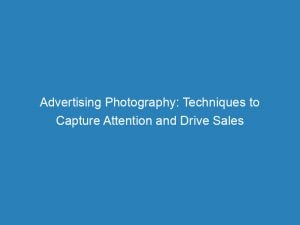In today’s visually-driven world, where attention spans are shorter than ever, the power of a striking image cannot be underestimated. Advertisingphotography, in particular, has the potential to captivate, compel, and convince audiences with its persuasive visuals.
It is an art that goes beyond mere aesthetics, utilizing principles of visual design and psychology to effectively engage consumers and convey messages. Whether it’s a sleek product shot or a dynamic campaign, the world of advertisingphotography demands a skillful blend of creativity and strategic thinking.
Join us as we explore this captivating realm, where captivating images reign and messages are woven with precision across all platforms.
Table of Contents
- advertising photography
- The Importance of a Strong Portfolio in Advertising Photography
- Specializing vs. Generalizing: What’s the Right Approach?
- Avoiding the Free Service Trap: Protecting the Value of Advertising Photography
- Building a Portfolio: Shooting for Free vs. Paid Gigs
- Gaining Experience: Choosing Projects Wisely in Advertising Photography
- Capturing Moments: The Historical Role of Photography in Advertising
- Engaging Consumers: Psychology and Perception in Advertising Photography
- First Impressions and Storytelling in Advertising Photography
- Visual Design Principles: Attention Manipulation and Message Conveyance
- Emotional Connections: The Power of Photography in Advertising
advertisingphotography
Advertising photography plays a crucial role in the commercial photography industry. Having a strong portfolio is essential for landing gigs in this competitive field.
It is not necessary to specialize right away, but it is important to avoid providing services for free as it can devalue the work and the industry as a whole. However, new photographers may choose to shoot for free initially in order to build their portfolio.
Gaining experience through personal projects and accepting paid gigs is recommended. Photography has a long history in advertising, capturing unique moments and conveying messages.
The use of psychology and perception is employed to engage consumers in advertising photography. First impressions and storytelling are important in this field, as they capture the attention and interest of the audience.
Manipulating attention and conveying messages effectively can be achieved by applying principles of visual design. Additionally, creating emotional connections with consumers is important in advertising photography.
Consistency between the advertisement and landing page is crucial for conversions. Stock photography can be a cost-efficient solution, but it doesn’t have to be generic.
When integrated correctly, stock photography can engage and inspire viewers. Personalization and the use of psychological principles can maximize the impact of stock photography.
Apple’s Think Different campaign is a prime example of effectively using stock photographs. Consistency in advertising campaigns leads to better conversion rates and ROI.
Personalized landing pages and optimization platforms can further enhance the impact of photography in campaigns.
Key Points:
- Advertising photography is essential in the commercial photography industry and requires a strong portfolio.
- It is important to avoid providing services for free to maintain the value of the industry.
- Gaining experience through personal projects and paid gigs is recommended for new photographers.
- Psychology and perception are used to engage consumers through photography and create emotional connections.
- Applying principles of visual design and storytelling are crucial for effective advertising photography.
- Consistency between advertisements and landing pages, as well as the use of stock photography, can enhance the impact of campaigns.
Sources
https://www.adobe.com/creativecloud/photography/discover/commercial-photography.html
https://instapage.com/blog/advertising-photography
https://www.photographypursuits.com/what-is-advertising-photography/
https://www.indeed.com/career-advice/career-development/advertising-photography
Check this out:
? Pro Tips:
1. Utilize social media platforms to showcase your advertising photography portfolio and attract potential clients.
2. Attend industry events and networking functions to connect with advertising professionals and find potential job opportunities.
3. Stay updated on current trends in advertising photography to ensure your work remains relevant and appealing.
4. Develop a strong understanding of lighting techniques and composition to create captivating and visually appealing photographs.
5. Consider collaborating with other professionals in the advertising industry, such as graphic designers or copywriters, to create cohesive and impactful campaigns.
The Importance of a Strong Portfolio in Advertising Photography
A strong portfolio is essential for photographers looking to secure gigs in the highly competitive commercial photography industry, particularly in advertising photography. It serves as a visual representation of the photographer’s skills, creativity, and ability to capture images that resonate with audiences.
With the increasing reliance on visual content in advertising, having a well-curated portfolio can significantly increase the chances of landing lucrative contracts.
Key Takeaways:
– A strong portfolio showcases the photographer’s unique style, technical expertise, and understanding of the advertising industry. – It acts as a doorway to potential clients who use the portfolio to determine if the photographer’s visual aesthetic aligns with their brand image and campaign goals.
- A portfolio should include a diverse range of work, demonstrating versatility and the ability to adapt to different campaigns and brands.
Specializing vs. Generalizing: What’s the Right Approach?
When starting out in advertising photography, new photographers often wonder whether they should specialize in a specific niche or generalize their skills to cater to a broader range of clients. While both approaches have their merits, it is not necessary to specialize right away.
Key Takeaways:
– Generalizing allows photographers to gain experience in various genres and develop a broad skillset. – Specializing can help photographers position themselves as experts in a niche market, increasing their chances of attracting clients looking for specific styles or subject matters.
- It is advisable for photographers to explore different genres and styles in the early stages of their careers to find their passion and develop their unique artistic voice.
Avoiding the Free Service Trap: Protecting the Value of Advertising Photography
Photographers should avoid providing their services for free as it devalues both their work and the industry as a whole. While it may be tempting for new photographers to offer free shoots to build their portfolio, it is essential to recognize the negative impact this can have on the advertising photography market.
By working for free, photographers undermine the value of their work and the expertise required to produce high-quality images.
Key Takeaways:
– Offering free services sets a precedent that photography has little or no monetary value, making it harder for photographers to command fair compensation in the future. – Instead of working for free, photographers can undertake personal projects or collaborate with other creative professionals to build their portfolio.
- Accepting paid gigs, even at a lower rate initially, allows photographers to gain experience and build a professional network while respecting the value of their work.
Building a Portfolio: Shooting for Free vs. Paid Gigs
When building a portfolio in advertising photography, photographers often face the dilemma of whether to shoot for free or only accept paid gigs. While it is generally recommended to avoid free work, there are certain scenarios where shooting for free can be beneficial for portfolio development and exposure.
Key Takeaways:
– Shooting for free can be an effective strategy to gain experience and build a portfolio in the early stages of a photography career. – However, photographers should carefully evaluate the potential benefits, such as exposure to a target audience or working with reputable brands, before accepting free gigs.
- As photographers gain experience and establish their reputation, they should transition towards primarily accepting paid gigs to secure fair compensation for their work.
Gaining Experience: Choosing Projects Wisely in Advertising Photography
In the world of advertising photography, gaining experience is essential for building credibility and attracting clients. However, new photographers must choose their projects wisely to ensure they align with their artistic vision and career goals.
By selecting the right projects, photographers can enhance their skills, expand their network, and build a reputation within the industry.
Key Takeaways:
– It is important to evaluate potential projects based on their alignment with personal style, desired target audience, and overall career trajectory. – Photographers should focus on projects that challenge their skills, push their creative boundaries, and offer opportunities for growth.
- Collaborating with experienced professionals in the advertising industry can provide valuable mentorship and open doors to new opportunities.
Capturing Moments: The Historical Role of Photography in Advertising
Photography has played a significant role in advertising for many years, capturing unique moments and conveying messages that resonate with consumers. From black and white print ads to vibrant digital campaigns, photography has consistently proven its ability to evoke emotions, tell stories, and create a lasting impact on viewers.
Key Takeaways:
– Captivating and visually appealing photographs have the power to capture the viewer’s attention and leave a lasting impression. – Advertising photography has evolved alongside advancements in technology, from traditional film cameras to modern digital equipment.
- Photography allows advertisers to showcase products, convey brand values, and create a connection with the target audience through visual storytelling.
Engaging Consumers: Psychology and Perception in Advertising Photography
Successful advertising photography relies on understanding the psychology of consumers and how perception influences their response to visual stimuli. By incorporating psychological principles, photographers can create images that engage viewers, elicit emotions, and drive action.
Key Takeaways:
– Colors, composition, and lighting are key elements of photography that can be manipulated to influence viewers’ emotions and perceptions. – Understanding the target audience’s preferences, desires, and aspirations allows photographers to create images that resonate with them on a deep, emotional level.
- Psychological cues, such as eye contact, body language, and facial expressions, can be used to establish a connection and build trust between the viewer and the brand.
First Impressions and Storytelling in Advertising Photography
In advertising photography, first impressions matter. Within seconds, viewers form opinions about a brand based on visual cues, making it crucial for photographers to create striking and memorable images.
By combining artistic composition and storytelling techniques, photographers can captivate viewers and convey a brand’s message effectively.
Key Takeaways:
– Attention-grabbing visual elements, such as bold colors, unique angles, and powerful subjects, can create a strong first impression. – Storytelling through photography allows advertisers to communicate brand values, evoke emotions, and create a narrative that appeals to the target audience.
- Whether it’s a single impactful image or a series of photographs, the story should be clear, cohesive, and align with the overall brand identity and message.
Visual Design Principles: Attention Manipulation and Message Conveyance
Visual design principles play a crucial role in advertising photography, enabling photographers to manipulate attention and effectively convey brand messages. By understanding and implementing these principles, photographers can create images that not only capture attention but also communicate ideas and key selling points.
Key Takeaways:
– Composition techniques, such as the rule of thirds, leading lines, and symmetry, can guide the viewer’s eye towards important elements within the photograph. – Color theory and contrast allow photographers to create visual impact and highlight specific aspects of the image.
- Typography and layout considerations help photographers incorporate text and branding elements seamlessly into the photograph.
Emotional Connections: The Power of Photography in Advertising
To maximize the impact of advertising photography, photographers must strive to create emotional connections with consumers. By eliciting emotions such as joy, nostalgia, or desire, photographers can forge a stronger bond between the viewer and the brand, ultimately driving sales and brand loyalty.
Key Takeaways:
– Understanding the desired emotional response from the target audience helps photographers create images that resonate on a personal level. – Authenticity and relatability are key factors in establishing emotional connections.
- Photographers can use staging, props, and models to evoke emotions and create a sense of lifestyle that aligns with the brand identity.
In conclusion, advertising photography is a powerful tool for capturing attention and driving sales. By having a strong portfolio, photographers can showcase their skills, develop their unique style, and attract clients.
Whether specializing or generalizing, photographers must choose projects wisely and avoid providing services for free to protect the value of their work and the industry. By understanding the historical role of photography in advertising and incorporating principles of psychology and visual design, photographers can create impactful and engaging images that connect with consumers on an emotional level.












